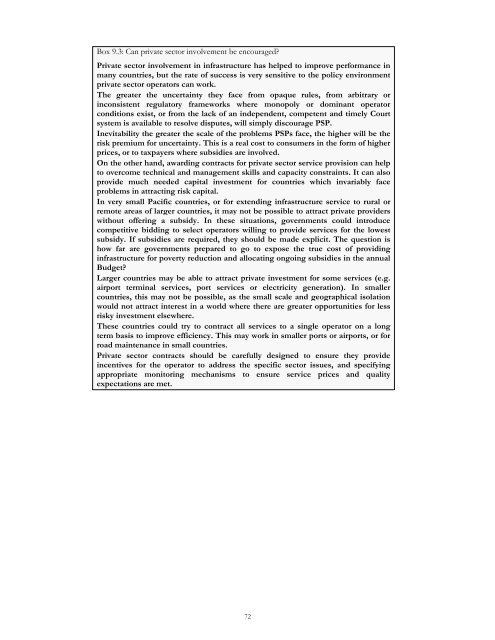EAP - The Pacific Infrastructure Challenge - World Bank (2006).pdf
EAP - The Pacific Infrastructure Challenge - World Bank (2006).pdf
EAP - The Pacific Infrastructure Challenge - World Bank (2006).pdf
Create successful ePaper yourself
Turn your PDF publications into a flip-book with our unique Google optimized e-Paper software.
Box 9.3: Can private sector involvement be encouraged<br />
Private sector involvement in infrastructure has helped to improve performance in<br />
many countries, but the rate of success is very sensitive to the policy environment<br />
private sector operators can work.<br />
<strong>The</strong> greater the uncertainty they face from opaque rules, from arbitrary or<br />
inconsistent regulatory frameworks where monopoly or dominant operator<br />
conditions exist, or from the lack of an independent, competent and timely Court<br />
system is available to resolve disputes, will simply discourage PSP.<br />
Inevitability the greater the scale of the problems PSPs face, the higher will be the<br />
risk premium for uncertainty. This is a real cost to consumers in the form of higher<br />
prices, or to taxpayers where subsidies are involved.<br />
On the other hand, awarding contracts for private sector service provision can help<br />
to overcome technical and management skills and capacity constraints. It can also<br />
provide much needed capital investment for countries which invariably face<br />
problems in attracting risk capital.<br />
In very small <strong>Pacific</strong> countries, or for extending infrastructure service to rural or<br />
remote areas of larger countries, it may not be possible to attract private providers<br />
without offering a subsidy. In these situations, governments could introduce<br />
competitive bidding to select operators willing to provide services for the lowest<br />
subsidy. If subsidies are required, they should be made explicit. <strong>The</strong> question is<br />
how far are governments prepared to go to expose the true cost of providing<br />
infrastructure for poverty reduction and allocating ongoing subsidies in the annual<br />
Budget<br />
Larger countries may be able to attract private investment for some services (e.g.<br />
airport terminal services, port services or electricity generation). In smaller<br />
countries, this may not be possible, as the small scale and geographical isolation<br />
would not attract interest in a world where there are greater opportunities for less<br />
risky investment elsewhere.<br />
<strong>The</strong>se countries could try to contract all services to a single operator on a long<br />
term basis to improve efficiency. This may work in smaller ports or airports, or for<br />
road maintenance in small countries.<br />
Private sector contracts should be carefully designed to ensure they provide<br />
incentives for the operator to address the specific sector issues, and specifying<br />
appropriate monitoring mechanisms to ensure service prices and quality<br />
expectations are met.<br />
72

















